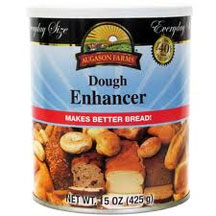Secrets to the BEST Bread
By Sydney Hill

You will be a better cook if you know what the ingredients you are using actually do. Here's why:
1. You'll know why something turned out the way it did (was really rich, didn't rise, etc.)
2. You can have more fun and experiment.
3. You can create your own recipes or adapt old ones
4. Make it the way YOU want it to turn out.

I have been trying to do that with my own baking. Learning what things do and experimenting. (I've got a lot to do before this scientist is pro.) But it's still so much fun, and I love that I get to try things the way I want to make them.
I've been trying to find more about what certain ingredients (like lecithin, dough enhancer, eggs) actually do? What's the point of using them? I did some research and came across this website.
https://www.breadmachinedigest.com/tips/dough-enhancers-and-how-to-use-them.php
Giving credit where credit is due, I loved the information they gave on this website! It's helpful to know what these baking agents do and how much to use.
I paraphrased most of the information below, but I encourage you to visit the site for all of the information.

Here are some things that an enhancer improves:
• Flavor
• Texture
• Crust
• Freshness
You use enhancers all the time:
• eggs
• sugar
• honey (also a preservative)
• a.k.a. Anything besides flour, water, yeast

What do they all do? (and how much do I use if I'm experimenting?)
Sugar: Helps bread rise, lighter bread
Amount used varies on sweetness of bread
Eggs: Leavening (lighter bread), preservative, moisture, color
1 large egg replaces about 1/4 cup of liquid in the recipe
Lecithin: Very similar to what eggs do as it is made from egg yolk or soy. (lighter bread, preservative, moisture)
1 Tbsp for every cup of flour
Non-Diastic malt: Feeds yeast, soft bread, structure (not malted milk. We don't want bread tasting like a whopper. I don't even like whoppers.)
1/4 teaspoon per cup of flour
Absorbic Acid: Helps yeast, makes it harder for mold and bacteria to grow
1/8 teaspoon per loaf
Dry Acid Whey: (not the same as dry whey) does almost the same thing as absorbic acid; helps bread rise quickly
1 teaspoon per cup of flour
Vital Wheat Gluten: Hard bread without it, not all flours need it.
1 Tablespoon per cup of flour
Pectin: Use instead of fat, adds moisture
1 teaspoon per loaf
Ginger: Keeps bread fresh, helps yeast, apparently it won't effect flavor?
1/4 teaspoon per loaf
Dry Milk: helps crust, flavor, moisture; easier to shape dough
1 Tablespoon per cup of flour
Gelatin (Unflavored): Texture and moisture, nutritional
1 teaspoon per loaf
Fats: moisture, flavor, takes away "chewiness"; breads don't use a lot, don't worry
1 Tablespoon per cup of flour
Buttermilk: yeast works quickly, moisture, freshness; if you don't want bread to be tart, add 1/2 tsp. baking soda
1/2 Cup replaces a 1/2 cup of other liquid in the recipe
Garlic: helps yeast, makes dough easier to work with, freshness of bread; does affect flavor
1 teaspoon per loaf
Cake flour: softer bread, easier to work with
Only replace 1/4 or less of the flour called for in the recipe
Dough Enhancers: When you buy these at the store, they usually contain many of the above ingredients. I found a 15 oz canister for 3 or 4 dollars. However, as Linda D pointed out in the Potato Cinnamon Roll article, you can make you're own! She found a recipe at https://chickensintheroad.com/cooking/how-to-make-homemade-dough-enhancer/ (Thanks Linda!)
The website I got the above information from also has a recipe:
Homemade Dough Enhancer
Ingredients:
1 cup vital wheat gluten
1 cup potato starch
or
1 cup instant potato flakes
1 package jelly powdered pectin
1 cup lecithin granuals
2 tablespoons vitamin C tablets - powdered
1 tablespoon ginger powder
1 cup dry milk powder
1/2 cup diastatic malt powder
1 envelope unflavored jello
Directions:
for 30 seconds. Remove enhancer to a glass or plastic container with a
tight fitting lid you can get a teaspsoon in to. To use add 1 tsp. of the
enhancer per 1 cup of flour called for in the recipe. No other adjustments
are needed.
Recipe formatted with the Cook'n Recipe Software from DVO Enterprises.

Reference: Dough with rolling pin image: Oat bread image: Bread with eggs image: Rising bread image: Dough enhancer image:
https://www.breadmachinedigest.com/tips/dough-enhancers-and-how-to-use-them.php
https://www.couponclippingcook.com/wp-content/uploads/2011/07/15-rolling-dough.jpg
https://2.bp.blogspot.com/-Ay_Y2XJvBAs/UHyAzw_ZneI/AAAAAAAAFA8/IIYE0f0xo4E/s1600/honey+and+oat+GF+bread+1.jpg
https://2.bp.blogspot.com/_OFpCCX-zBts/TSvXVyi0F9I/AAAAAAAANis/tzKyCqfweXA/s400/Rolling+Pin+with+Flour+on+Board.jpg
https://cookshootblog.com/wp-content/uploads/2010/04/BreadDough.jpg
https://911emergencysolutions.com/wp-content/uploads/2012/05/90900_ED_Dough_Enhancer__61198_zoom.png

Contribute to the Cook'n Club!
DVO would love to publish your article, prose, photography and art as well as your cooking, kitchen and nutrition tips, tricks and secrets. Visit the Newsletter Submission / Win Win for All section in our Forum for more information and details.

